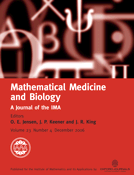-
Views
-
Cite
Cite
Ian Sobey, Benedikt Wirth, Effect of non-linear permeability in a spherically symmetric model of hydrocephalus, Mathematical Medicine and Biology: A Journal of the IMA, Volume 23, Issue 4, December 2006, Pages 339–361, https://doi.org/10.1093/imammb/dql015
Close - Share Icon Share
Abstract
We examine a spherically symmetric model of the brain and apply non-linear permeability in a small strain poroelastic framework. Numerical solutions to the model show that non-linear effects tend to improve predictions of ventricle wall displacement and pressure increase in acute hydrocephalus in comparison with a constant permeability model. Our model is used to study different mechanisms for hydrocephalus: complete blockage of the aqueduct and normal pressure hydrocephalus (NPH), as well as offering observations on mechanical effects in idiopathic intracranial hypertension. In each situation it is possible to apply different parameter conditions to quantify mechanical effects that correspond to some observed symptoms. The results support and quantify ideas from Levine (2000, Ventricle size in pseudotumor cerebri and the theory of impaired CSF absorption. J. Neurol. Sci., 177, 85–94) on a poroelastic mechanism for some features of NPH and idiopathic intracranial hypertension.





